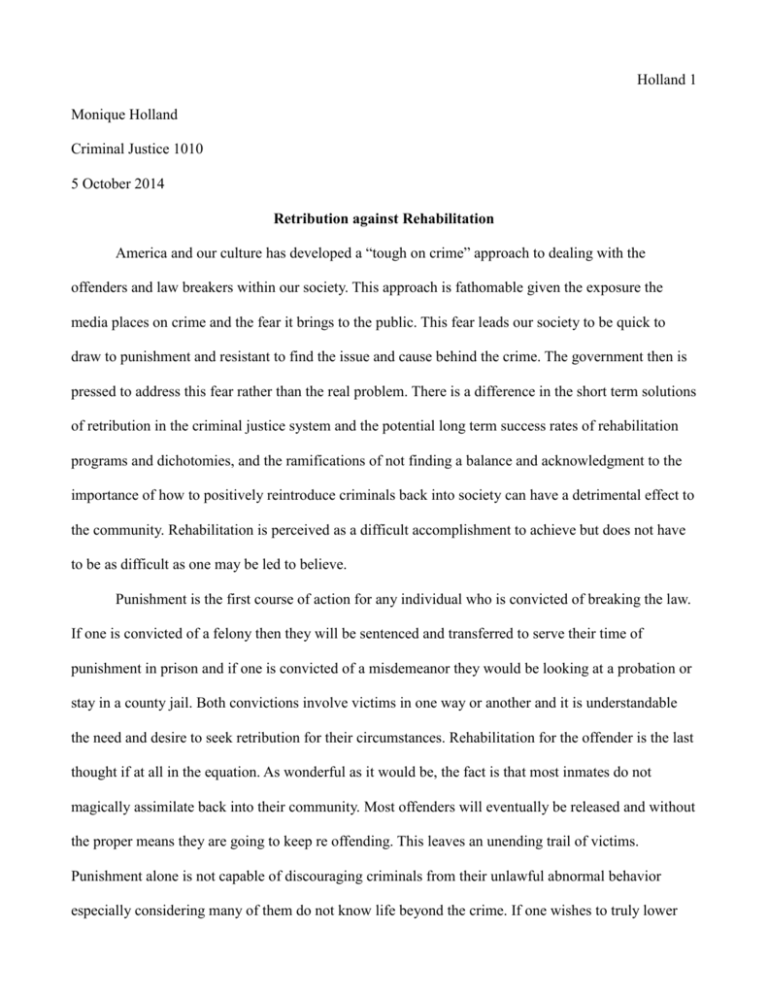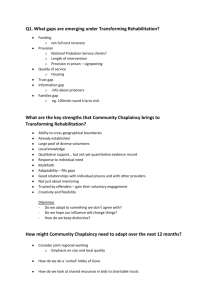CJ_CriticalThinkingEssay2014 (1)
advertisement

Holland 1 Monique Holland Criminal Justice 1010 5 October 2014 Retribution against Rehabilitation America and our culture has developed a “tough on crime” approach to dealing with the offenders and law breakers within our society. This approach is fathomable given the exposure the media places on crime and the fear it brings to the public. This fear leads our society to be quick to draw to punishment and resistant to find the issue and cause behind the crime. The government then is pressed to address this fear rather than the real problem. There is a difference in the short term solutions of retribution in the criminal justice system and the potential long term success rates of rehabilitation programs and dichotomies, and the ramifications of not finding a balance and acknowledgment to the importance of how to positively reintroduce criminals back into society can have a detrimental effect to the community. Rehabilitation is perceived as a difficult accomplishment to achieve but does not have to be as difficult as one may be led to believe. Punishment is the first course of action for any individual who is convicted of breaking the law. If one is convicted of a felony then they will be sentenced and transferred to serve their time of punishment in prison and if one is convicted of a misdemeanor they would be looking at a probation or stay in a county jail. Both convictions involve victims in one way or another and it is understandable the need and desire to seek retribution for their circumstances. Rehabilitation for the offender is the last thought if at all in the equation. As wonderful as it would be, the fact is that most inmates do not magically assimilate back into their community. Most offenders will eventually be released and without the proper means they are going to keep re offending. This leaves an unending trail of victims. Punishment alone is not capable of discouraging criminals from their unlawful abnormal behavior especially considering many of them do not know life beyond the crime. If one wishes to truly lower Holland 2 recidivism and lower crime rates then their needs to be focus on understanding the cause. (Erfel,2011) Rehabilitation involves personal counseling and a formal education. There is controversy about funding programs for inmates since the majority involves receiving the funds through the pockets of the public in the form of taxes. This leads to the public feeling a sense of unfairness and the idea that criminals who are locked up to be penalized are given a “free ride”. However, the alternative is leaving the inmate in solitary or wasting their time in informal educations. Our correctional facilities have come to develop informal educations among the inmates as a survival within the subculture of prison life. One is taught to be hard and how to survive the fittest of the cruelest and gain coping mechanisms to assimilate into their new found subculture and abnormal experiences. They can delve so deep into this dichotomy of living that they loose the needed tools to integrate back into civil society. The longer they are kept away the harder it becomes to be a “normal” part of society outside of incarceration. The concept of expanding their mind to teach them beyond life behind bars gives them the ability to see past the bars and embraced in an atmosphere that encourages the potential of their better selves. We can create an ideal model by combining productive use of the time an inmate is locked up and utilizing the opportunity to counsel them and learn new ways to reform both the inmate and the crime cycle. (Hill, 1997)(Irwin, 1997)(Thomas, 1997) There is a high cynicism to the effectiveness of rehabilitation however research by psychologist continue to show evidence against the pessimism showing that when implemented properly psychotherapy, education, and work programs greatly effect the inmates ability to function among normal society and are able to ease their new transitions back into the free world. There is also a debate about cost to funding such programs however the question to consider is if funding should be placed on keeping them locked up or aiding them to function effectively in the community? However California found one solution that did not effect the tax income in their system. The San Quentin State Prison administered a volunteer staffed program that allowed a non profit prison university program for Holland 3 inmates to earn an associate's degree. Since it is volunteer based the program does not effect the state or federal funds. (Erfle, 2011) The irony behind our tough on crime approach is that it has actually expanded prison population growth and little effect on crime rates. The U.S. Department of Justice estimates that more than 2 million U.S. Residents are in prisons or jails, this equals one in every 142, of that population 15-20 percent suffer a mental illness. Although psychologists are primarily the mental health providers, they are not adequately given the means to fulfill full evaluations or follow through. Programs for rehabilitation struggle to get implemented due to low funding and overwhelming case loads. Robert Morgan, PHD, psychologist at Texas University quoted in an article in the American Psychological Association “we're focused so much on the basic mental health services that there's not enough time or emphasis to devote to rehabilitate services” in that same article Etienne Benson points out “Psychologist are not only providing treatment to prisoners; they're also contributing to debate over the nature of prison life.” in essence calling out the whole system as flawed. (Benson, 2003,P46) It is hard to focus on an effective rehabilitation plan when the eye is on punishment and the criminal justice system is punitive in nature. (Laurel, 1994)(Cheatwood, 1986)(Maguire, 1999). To emphasis how the nature of prison impacts those involved psychologists have conducted a study known as The Stanford Prison Experiment. The experiment involved students who were separated to play the roles of prisoners and guards in a mock prison set up. The students adapted to their new found roles beyond what was expected as those playing the guards enforced extreme authoritarian measures and psychological torture and those in the roles of the prisoners accepted and allowed the abuse and even became manipulated to repeat it among each other. These students were evaluated previous to the experiment and considered to be psychologically healthy but placed under the circumstances were able to abnormally treat each other sadistically and cecum to a depression both during and after the experiment. This was a mock prison-like environment, in real prison there is no off Holland 4 switch when the guards and prisoners start becoming humanly destructive.(Benson,2003). Another current study being performed by Craig Haney, PHD, psychologist at University of California, Santa Cruz points out the negative outcomes of solitary confinement in super max prisons. These prisoners experience as long as 23 hours per day stuck in solitary which leads to extreme anxiety and negative emotions and then released without a decompression period. Haney states “This is what prison systems do under emergency circumstances—they move to punitive social control mechanism,..[But] it's a very short term solution, and one that may do long-term damage both to the system and to the individuals than it solves.”(Benson, 2003,Vol 34, No7, P46). The truest form and most effective rehabilitation would be to implement treatment upon arrival. Staff mental health professionals to evaluate and review full background analysis and observations of behavior to properly determine a treatment plan to transition from inmate to contributing member of society. The recommendations would be mandate required to complete in order to earn their freedom. The failure in the system is not that these programs are unavailable it is that they are not always implemented or taken seriously. An individual in the system in many cases is exposed to worsened circumstance then the common limited environment from which they came. They have learned nothing beyond the punishment, still hold limited resources, and with impaired social skills are unable to assimilate into the mainstream population. Chris Bowes, an inmate in the California Department of Corrections and Rehabilitation was published in an article in 2008 that sums up these claims and he captures the experience when he states “The institutions that were initially designed to bring about redemption and reform have collapsed into retributive warehouses. Mindlessly, we dump people into concrete and steel coffins, bury them in lengthy sentences and abandon them to rot. Entombed, the decomposing nameless corpses are hollowed by the parasites of condemnation, solitude and banishment. They have attempted to make me one of those corpses in prison. And though I may be incarcerated, I refuse to be one of those.” Holland 4 REFERENCES: American Correctional Association. (1994b). Standard 3-4081. In American Correctional Association, standards Supplement (pp.20-22).Laurel, MD: American Correctional Association. Applegate, B.K. (2001). Penal Austerity: Perceived utility, desert, and public attitudes toward prison amenities. American Journal of Criminal Justice, 25, 253-268. Benson, Etlenne. (2003) Rehabilitation or Punish?(Vol.34, No 7, P46). Bowes, Chris (2008) Retribution vs. Rehabilitation. California Department of Corrections. Cheatwood, D., & Hayeslip, P. (1986). Reasonable expectations in correctional officer training: Matching methods to audience. Issues in correctional training and casework, 3(October), 15-18. Erfle, Julie (2011), A New Prison Formula: Retribution+Rehabilitation=Reform, American journal of Criminal Justice, (Vol.27,Issue 1, pp.1-17) Hill, G. (1997). Correctional officer traits and skills. Corrections Compendium, 22(8), 1-2. Irwin, J., & Austin, J.(1997). It's about time: America's imprisonment binge. Belmont, CA: Wadsworth Publishing. Lauren, R. J. (1997). Positive approaches to corrections: Research, policy, and practice. Laurel, MD: American Correctional Association. Maguire, K., & Pastore, A.L. (1999). Source book of criminal justice statistics. Washington, D.C.:U.S. Government Printing Office. Thomas, C.W., & Petersen, D.M. (1977). Prison organization and inmate subcultures. Indianapolis, IN: Bobbs-Merrill.






